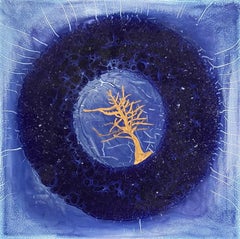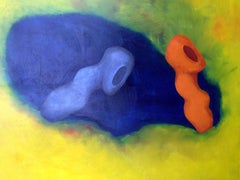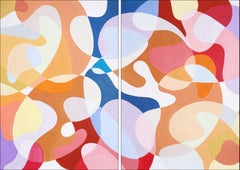Frank Olt Mixed Media
American, b. 1956
Frank Olt is a Professor of Art and Ceramics at CW Post College in NY. He was an artist in residence at PS1 the legendary art studio gallery complex in Long Island City, NY in the 1970's. Frank Olt largely considers himself to be a self taught artist , identifying his influences as Pollock, Johns, Kelly Rothko and Ray Johnson who he met and befriended in the 1970's. His work spans 40 years of traditional ceramics and encaustic paintings with his style evolving over his career and worldwide travels studying the various traditional methods of ceramics and painting. His work remains very much his own unique style that is very much color field, almost abstract and more often than not reflects the landscape around him so keenly observed. Spending summers on Fire Island NY with its unique light and landscape is often seen in works created during those summers.
Olt has shown in Brooklyn, Manhattan, and Long Island and Asia. His work is highly regarded as a hybrid of both a modern ceramists, though you will find a kiln in his studio, and an abstract painter, though you will find no brushes in his studio either.
Olt is still living and working on Long island, with his family.
His studio is located in Oyster Bay Long Island
PERMANENT COLLECTIONS
Bellevue Hospital, New York, NY Ceramics Monthly Magazine, Westerville, OH
C.W. Post College, Brookville, NY Friends Academy, Locust Valley, NY
Heckscher Museum, Huntington, NY Islip Art Museum, Islip, NY
Konggi Museum, Sowon, Korea Kyung Hee University, Seoul, Korea
Kyung Sung University, Pusan, Korea Marywood University, Scranton, PA
M.T.A. Arts for Transit, New York, NY Nassau County Museum of Art, Roslyn, NY
Woodhull Hospital, Brooklyn, NY North Shore University Hospital, Manhasset, NY
to
1
Overall Width
to
Overall Height
to
1
1
1
1
4
270
267
150
142
1
Artist: Frank Olt
Wreath of Life, deep midnight Blue with gold leaf tree
By Frank Olt
Located in Brookville, NY
Frank Olt finds most of his creative images in the landscape. The suggestion of a late night sky with a silhouette on the Arboretum like property that he lives on. The vivid deep blues surround the golden tree with sprays of moonlight coming from the edges. A ceramic and encaustic on panel, mounted for hanging installation.
Category
2010s American Modern Frank Olt Mixed Media
Materials
Ceramic
Related Items
Modernist Blue & Yellow Abstract
By Grady McDonald
Located in Soquel, CA
Beautiful oil abstract titled "Coming Out" by Grady McDonald (American, 1938-1980). Signed lower right, titled and dated 1974 on verso. Unframed. Image, 50”H x 44”W.
Grady McDona...
Category
1970s American Modern Frank Olt Mixed Media
Materials
Canvas, Oil
Rainbow Curves, Painter's Palette Translucent Shapes, Large Diptych on Paper
By Ryan Rivadeneyra
Located in Barcelona, ES
This is a modernist-inspired painting, drawing influence from the bold creativity of 1950s, 60s, and 70s art. The composition features overlapping painter’s palette silhouettes, crea...
Category
2010s American Modern Frank Olt Mixed Media
Materials
Oil, Paper
$800 Sale Price
20% Off
H 40 in W 55.2 in
Large Scale Modernist Abstract Square and Circle
Located in Soquel, CA
Wonderful large scale natural toned mixed media abstract comprising a rectangle of antiqued white texturized with gesso'd hemp sacking and set above second ivory rectangle in pale ivory with circle of scumbled grey by British contemporary artist Richard Lawrence...
Category
1980s American Modern Frank Olt Mixed Media
Materials
Gesso, Canvas, Oil
$3,256 Sale Price
45% Off
H 59.75 in W 50 in D 1.5 in
1950s "Sitting in Chair" Mid Century Figurative Pratt Graphic Arts Center
By Donald Stacy
Located in Arp, TX
Donald Stacy
"Sitting in Chair"
c.1950s
Gouache and oil pastel on paper
24" x 18" unframed
Came from artist's estate
*Custom framing available for additio...
Category
Mid-20th Century American Modern Frank Olt Mixed Media
Materials
Paper, Oil Pastel, Gouache
$570 Sale Price
40% Off
H 18 in W 24 in
Mid-Century Modern Abstract Geometric Trapeze Artists by Hilda Arp
By Hilda Arp
Located in Soquel, CA
Fanciful mid-century modern abstract of trapeze artists by Brooklyn artist Hilda Dora Pape Arp (b. 1909). This 1962 highly abstracted depiction of trape...
Category
1960s American Modern Frank Olt Mixed Media
Materials
Oil, Linen
$1,725 Sale Price
34% Off
H 28 in W 22 in D 3 in
Mid-Century Modern Abstracted Cubist Table Still-Life in Acrylic on Masonite
Located in Soquel, CA
Mid-Century Modern Abstracted Cubist Table Still-Life in Acrylic on Masonite
Vibrant mid-century modern still life with abstracted synthetic cubist elements in warm colors, highligh...
Category
1970s American Modern Frank Olt Mixed Media
Materials
Masonite, Acrylic
$1,072 Sale Price
35% Off
H 18.13 in W 23 in D 1.25 in
"On Guard" Heavy Impasto Expressionist Figure
Located in Soquel, CA
"On Guard" Vintage Abstract Expressionist Heavy Impasto Figure
Abstract expressionist figurative composition of a man in a button down shirt with a brimmed hat by California artist ...
Category
1970s American Modern Frank Olt Mixed Media
Materials
Canvas, Oil, Stretcher Bars
$2,275 Sale Price
35% Off
H 40 in W 30 in D 1 in
Mid Century Antica Roma Figurative Abstract Collage
By James Coughlin
Located in Soquel, CA
Stunning mid century mixed media collage of Roman travel items and photos by James A. Couglin, a Berkeley Abstract Expressionist (American, 1929-1979), c.1966. Painted during his Par...
Category
1960s American Modern Frank Olt Mixed Media
Materials
Paper, Acrylic, Permanent Marker, Magazine Paper
$1,580 Sale Price
20% Off
H 30.75 in W 28.5 in D 1 in
Mid Century Yellow and Blue Large Scale Abstract
By Louis Earnest Nadalini
Located in Soquel, CA
Stunning and expressive large scale oil painting by mid-century San Francisco artist Louis Earnest Nadalini (American, 1927-1995). Signed "Nadalini" lower right. Unframed. Image size...
Category
1950s American Modern Frank Olt Mixed Media
Materials
Canvas, Oil, Wood Panel
$2,800 Sale Price
20% Off
H 64 in W 48 in D 1 in
Johann Strauss & Artie Shaw - Mid Century Modern Abstract
By Clark Blocher
Located in Soquel, CA
Johann Strauss & Artie Shaw - Mid Century Modern Abstract
Swirling vortex of color and the words: "Johann Strauss' Tale(s) from the Vienna (Woods) Artie Shaw & Orchestra" by Kansas ...
Category
1960s American Modern Frank Olt Mixed Media
Materials
Masonite, Oil
$2,275 Sale Price
35% Off
H 18.07 in W 16 in D 0.07 in
Colorful Samurai, Large-Scale Modern Figural Geometric Abstract
Located in Soquel, CA
Colorful Samurai, Large-Scale Modern Figural Geometric Abstract
Colorful modern figural abstract of a samurai figure fractured into fields of color and pattern by S. Baker (Susan Baker...
Category
1990s American Modern Frank Olt Mixed Media
Materials
Canvas, Oil, Stretcher Bars
$2,372 Sale Price
35% Off
H 42 in W 36 in D 2 in
Cosmos and Tree Original Abstracted Composition
Located in Soquel, CA
The Cosmos and Tree - Original Abstracted Composition by Dave Francis
Unique and thought-provoking abstracted composition with cosmos and oak tree by California artist Charles "Dave...
Category
Late 20th Century American Modern Frank Olt Mixed Media
Materials
Acrylic, Laid Paper, Paper
$780 Sale Price
35% Off
H 30 in W 24 in D 0.25 in
Frank Olt mixed media for sale on 1stDibs.
Find a wide variety of authentic Frank Olt mixed media available for sale on 1stDibs. If you’re browsing the collection of mixed media to introduce a pop of color in a neutral corner of your living room or bedroom, you can find work that includes elements of purple and other colors. You can also browse by medium to find art by Frank Olt in ceramic and more. Much of the original work by this artist or collective was created during the 21st century and contemporary and is mostly associated with the modern style. Not every interior allows for large Frank Olt mixed media, so small editions measuring 12 inches across are available. Customers who are interested in this artist might also find the work of Tom Binger, Philomena Marano, and Jack Hooper. Frank Olt mixed media prices can differ depending upon medium, time period and other attributes. On 1stDibs, the price for these items starts at $4,500 and tops out at $4,500, while the average work can sell for $4,500.


